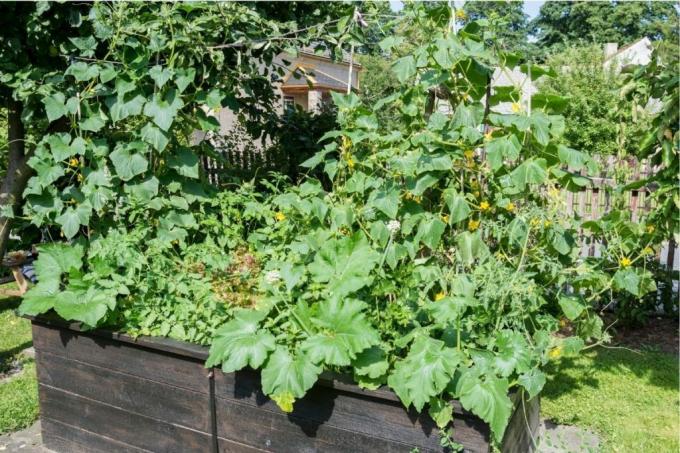
table of contents
- Prepare the raised bed
- Prefer - Instructions
- Best time to plant
- Instructions for planting
- Attach climbing aids
- Care in the raised bed
- frequently asked Questions
Untreated Cucumber from our own harvest cannot be compared with those from the supermarket. They are much fresher and more aromatic. You can also grow your own cucumbers in the raised bed.
In a nutshell
- Growing cucumbers in a raised bed is straightforward and has several advantages
- Rotting organic material in the raised bed ensures sufficient warmth
- Soil for the cucumbers is well ventilated with proper layering
- Raised bed is particularly suitable for heavy eaters such as cucumbers
- first crops in newly created raised beds should be heavy consumers
Prepare the raised bed
A loose and humus-rich soil can heat up faster and store sufficient water, which is ideal for cucumbers in raised beds. So that the bed offers ideal conditions for growing cucumbers, it should be structured accordingly.
- from fresh layers of decaying plant parts, compost and soil
- Correct stratification is one of the deciding factors for success or failure
- Before filling wire mesh to protect against voles on the floor
- on top of it a ten centimeter thick layer of coarse tree and shrub cuttings
- followed by four inches of chopped twigs or unrotted compost
- in the next step, ripe compost soil, 15 cm thick
- then a 20 cm thick layer of ripe compost soil
- or a mixture of normal garden soil and coarse compost
- A 20 cm thick layer of garden soil forms the end

Note: Due to the natural rotting process, the contents of the raised bed collapse by about 10-20 cm within a year. This loss can easily be compensated for with soil.
Prefer - Instructions
Cucumbers can be preferred or sowed directly in the raised bed. The trade will also offer early-grown young plants in due course. However, direct sowing is risky because the seeds cannot tolerate frost. Growing the plants in the greenhouse or on the windowsill is relatively easy and has the advantage that you can choose between several varieties.
- start with the preculture from the beginning / middle of April
- no earlier than two to three weeks before planting
- If necessary, soak seeds for 24 hours
- Fill small pots about halfway with potting soil
- Put one to three seeds in each pot
- Cover thinly with substrate
- Moisten the substrate and keep it moist
- Put the cling film over the pots
- put in a light and warm place
- Germination temperature at least 20 degrees
- Place a little cooler after germination
- plant out the strongest plants
Before planting self-grown cucumbers in the raised bed, it is advisable to give them a hardening phase in advance. You can do this by placing them in a warm, partially shaded and sheltered place outdoors during the day from around the beginning of May. The plants should still spend the night indoors.
Best time to plant
Cucumbers can only be planted in raised beds after the ice saints at the earliest, because the plants cannot tolerate frost. If you plant them out too early, they can go into cold shock and die. It is best to measure the soil temperature, because it should have warmed up to at least 15 degrees at the time of planting. The plants themselves should have developed two to four leaves in addition to the cotyledons in order to survive outdoors. Incidentally, after the ice saints, it is also the right time to sow cucumbers directly.

Tip: If you can't decide between lettuce, snake, pickled or mini cucumbers with the abundance of cucumber varieties, it is best to start with simple cucumbers, which almost everyone likes.
Instructions for planting
Cucumbers are plants that need warmth and therefore love sun-drenched, humid and sheltered locations. It is best to place them on the south side of the raised bed.
- first plant holes in the ground, depending on the number of plants
- as deep as possible and about 30-35 cm apart
- Sufficient plant spacing is important for good ventilation of the plants
- otherwise there is a risk of powdery mildew
- Carefully remove young or previously grown young plants from the pots
- Avoid damaging fine roots if possible
- so deep in the earth that the cotyledons are covered with earth
- Foliage leaves should be above the ground
- Finally, press the soil and water the plants
Note: In the following two years after cucumber cultivation, so-called middle eaters such as Kohlrabi, Swiss chard, carrots or leeks and, from the fourth year on, low-eaters such as rocket, lamb's lettuce or herbs plant. This ensures the best possible use of the raised bed.
Attach climbing aids
As soon as the plants start to grow, they should be given a hold Climbing aid give. These can be individual rods that are connected with cords or wires or between which an insect protection net is stretched, but also finished trellis or so-called cucumber carriers.
- without climbing support, the cucumber plants grow downwards
- spread around the bed
- Fruits lie flat on the ground, risk of rot
- Plants are large enough and well branched after a few weeks
- Attach the main shoot and the side tendrils to the climbing aid
- do not leave too many branches on the plant
- Side shoots and main shoot from a certain height or Cap length

The more power goes into the side shoots, the less goes into the main shoot and thus also into fruiting. If you do not use climbing aids and the cucumbers in the raised bed grow towards the ground, there is a risk that snails will take advantage of this and get into the raised bed via the tendrils. There they can cause great damage.
Care in the raised bed
Once the cucumbers have been set in the raised bed, regular watering is important, and not just on particularly hot and dry days. The soil should always be kept moist and the irrigation water should not be too cold. In addition, you should not pour over the leaves, but only below, i.e. on the ground. If the raised bed is newly created, you can usually do without additional fertilizer. Otherwise it is sufficient to fertilize regularly with nettle manure, of course diluted accordingly. Or you can give a commercial vegetable fertilizer about every two weeks, ideally in organic quality.
frequently asked Questions
Seeds that you harvest yourself can damage your health. The cucumber belongs like zucchini and pumpkin to the cucurbits. Their fruits from their own seeds usually contain poisonous bitter substances (cucurbitacins). A taste test provides information about the palatability, so to speak.
Cucumbers in the raised bed go very well with leeks, celery, peas, beans, fennel, dill, savory, cabbage, kohlrabi, carrots, zucchini and potatoes. With tomatoes, Radish and radishes, on the other hand, do not get along at all. Diseases could also be transmitted more easily in this way.
Cucumbers should only be grown in the same place every four years. But the raised bed is now also suitable for many other cultures. The best way to improve the soil in autumn is to apply green manure. The leached earth is enriched again with organic matter, supplied with nutrients and loosened.


